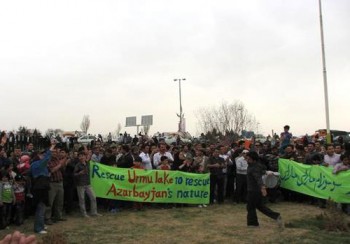Iran Feature: Is Civil Disobedience Taking Off? (Tait)
 Protest over Lake UrmiaRobert Tait reports for Radio Free Europe/Radio Liberty, with a cameo appearance by EA:
Protest over Lake UrmiaRobert Tait reports for Radio Free Europe/Radio Liberty, with a cameo appearance by EA:
When Leon Panetta, the new United States defense secretary, declared on September 6 that it was only "a matter of time" before an Arab Spring-style revolution came to Iran, it seemed to smack of wishful thinking.
And since this year's outbreak of popular uprisings that have unseated dictatorships in Tunisia, Egypt, and Libya, and destabilized authoritarian regimes elsewhere in the Middle-East countries, there have been numerous expressions of desire for a "Persian Spring" to go with the Arab variety.
Yet now opponents of the Tehran regime feel its nemesis may finally have arrived -- in the form of proliferating acts of civil disobedience.
"The Iranian regime faces a threat even more daunting than the 2009 Green Movement protests: a disparate yet potentially powerful civil disobedience movement motivated not just by politics, but by environmental, economic, and social issues," wrote Alireza Nader, an international policy analyst at the RAND Corporation, in a recent blog post.
The first sign, according to Nader, appeared in July with an organized water pistol fight among young men and women in Tehran that triggered mass arrests and provoked angry questions in the Majlis, Iran's parliament, about an alleged assault on public morals and decency. Attempts to organize more water fights as a protest against the regime's social restrictiveness have subsequently been made on Facebook, leading to yet more arrests.
Then in late August, a wave of protests occurred over the drying up of Iran's biggest lake, Lake Orumieh [Urmia], straddling West and East Azerbaijan provinces, which has lost more than half of its volume in recent years due to extensive dam-building projects and drought.
An initial demonstration by environmentalists on August 27 resulted in multiple arrests and brought the lake's plight to wider notice. It was followed a week later by much bigger protests in the cities of Orumieh and Tabriz -- footage from which was posted on YouTube -- that appeared to tap into wider discontent in Iran's Azeri-speaking regions and which were reportedly met by live fire from riot police.
RFE/RL's Radio Farda reported on September 15 that more activists had been arrested for trying to organize further protests over Lake Orumieh.
Nader argues that anger over the lake is mirrored by discontent over a multitude of other issues. "The Azeri demonstrators are not merely motivated by a drying lake or ethnic aspirations," he wrote. "They are driven by the anger, frustration, and indignity felt by Iranians regardless of race, religion, or gender. The Islamic Republic has left Iranians no choice but to disobey."
Trita Parsi, president of the National Iranian American Council, also believes the regime is peculiarly vulnerable to nonviolent disobedience.
"What's so interesting with these campaigns is that they probably have a much larger number of issues that they can focus on," he says. "Who would have expected a year ago that the issue of Orumieh would have reached essentially a national scale right now? I think there can be plenty of examples and I think the government rightly is far more concerned by these forms of nonviolent protest than they are concerned about efforts by certain groups to pursue violence. They know how to handle violence. They don't know how to handle nonviolence."
However, Scott Lucas, an Iran specialist at Birmingham University in the U.K. and editor of the EA WorldView website, cautions that while such localized protests have the potential to grow, there is as yet no evidence that they can provide a bigger challenge to the regime than the Green Movement
"The regime has effectively disrupted the organizations behind a lot of that disobedience," argues Lucas. "They've disrupted the student organizations, they've disrupted the lawyers, they've disrupted women's rights activists and so their response on the Lake Orumieh protests is that they swept up [demonstrators], we've got estimates of up to 300 people."
"A lot of those were just general detentions. Some of those people, however, were journalists and some of them were activists. They will try to basically defang the movement.
"The question is whether they can defang a whole set of specific movements if they all pop up at the same time. We are not at that point yet to be able to answer that question," Lucas says.

 Saturday, September 17, 2011 at 18:50
Saturday, September 17, 2011 at 18:50
Reader Comments